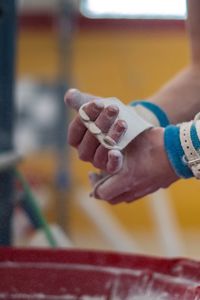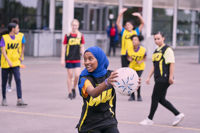
Governance lessons from the Whyte Review
Following the publication of the Whyte Review into allegations of mistreatment within gymnastics, Craig Beeston looks at some of the lessons to be learned.
Date: 22nd Jun 2022
Author: Craig Beeston, The Chartered Governance Institute UK & Ireland
Last week’s report from Anne Whyte QC into allegations of mistreatment within gymnastics was another sobering read for the sports sector. The findings, delayed due to the scale of the response to the review, laid out starkly a range of failures of behaviour, oversight, process and culture.
The origins of the review lay in disclosures made to the press in the summer of 2020 by current and former British gymnasts. These followed the broadcast of the documentary Athlete A, which detailed the sexual abuse scandal in the sport in the US. Anne Whyte was commissioned by UK Sport and Sport England to undertake an independent review of the handling of safeguarding concerns and complaints within the sport between 2008 and 2020, the ability of gymnasts and others to raise complaints, and the place of gymnasts’ wellbeing and welfare in British Gymnastics and its clubs.
The scale of the problem
Over 400 submissions were received. More than 40% of these detailed physically abusive behaviour, from excessive training loads and physical punishment to withholding of food and water and the denial of toilet breaks. Over half of submissions described emotional abuse such as inappropriate communications, controlling behaviour and belittling language. The vast majority of reports appear to have related to female gymnasts and at the elite level of the sport.
Though 30 submissions involved allegation of sexual abuse, the report concludes that this was not systemic and that there was a better understanding of the seriousness of such reports than of the other forms of abuse identified.
At the heart of Anne Whyte’s findings is the conclusion that gymnast wellbeing and welfare was not at the centre of British Gymnastics’ culture for much of the period. This manifested in behaviour which was not detected or went unchallenged – despite often taking place in plain sight – a reluctance by those who experienced it to enter a complaint due to a lack of expectation of a satisfactory outcome or to fear of repercussions, and reporting and oversight processes which lacked the efficacy to highlight the issue.
A culture gone awry
The report identifies a coach-led culture, enabled in part by a de-centralised network of schools, gyms and facilities which lacked effectual oversight, education, effective policy implementation and accountability.
The coach-athlete relationship is a crucial one which should be based on trust, clear boundaries and a duty of care. There are countless examples up and down the country where this is the case and rewards both parties hugely. It is disturbing, therefore, to read that it became, at times, ‘quite normal for a highly successful young gymnast to be frightened of the very person towards whom they simultaneously felt immense gratitude and affection’. Whyte describes these relationships – ‘intense, protracted and quasi-parental’ – as dysfunctional. They are also pernicious.
Sport should be a safe and positive experience for those who participate and where there are concerns that standards of behaviour have been breached, those involved should feel confident that they can speak up, that they will be heard and that their concerns will be dealt with robustly and appropriately. This was not the case, despite the clear risks arising from the demographics of the sport and the training environment.
The failings identified in the review are both cultural and procedural – though the two are not unconnected.
Clearly, the culture which had grown within the sport of gymnastics had gone seriously awry. But who is responsible for an organisation’s culture?
It is customary to argue that this comes from the top: the board. Certainly, the board should set the values of the organisation and satisfy itself that these are being lived, taking corrective action where they are not. For this it requires information. The inadequate case management and poor record-keeping identified by Anne Whyte for much of the period under review (improvements were made after 2016) surely hampered data collation and analysis and represents a major failure in oversight. Moreover, she observed what amounted to a lack of appetite on the part of the board to learn the extent of the cultural malaise within British Gymnastics and the prevalence of emotional and physical abuse. They should not have been taken by surprise. The leadership had focused, Whyte concludes, on success and financial security and not on culture, safeguarding, welfare and the voice of athletes.
Culture also belongs to the organisation as a whole. When unacceptable behaviour is normalised by its prevalence, when there is an absence of faith in or aversion to using remedial processes, where complaint handling systems are unfit, and where inappropriate and outdated methods are seen to yield results, an adverse culture develops.
While the report notes a number of other governance failures – for example, conflicts of interest in line management – it is the inattention paid to effective safeguarding, welfare, complaint management and organisational culture that are the most damaging. Whyte correctly notes that these are critical functions, go largely unnoticed when done well but do not deliver tangible, commercial returns. Their neglect, is costly, most of all in human terms.
Going forward
The report has raised once again the question of the price of success in the sector. We all need to revisit what constitutes ‘success’ in sport and physical activity and ensure that it is defined holistically. Where ‘performance’ forms part of the definition, vigilance, cultural alignment and education are essential to make sure that it is achieved sustainably and in the right way – with the interests of participants at the core. Whyte suggests too that the creation of an ombudsman, recommended by Dame Tanni Grey-Thompson in 2017, is a step in the right direction.
It should be noted that improvements have been made within gymnastics in terms of personnel, structure and policies since the period under review. The implementation of the recommendations to address remaining issues will be watched keenly, alongside the creation of an appropriate culture.
The revised Code for Sports Governance now places a requirement on funded organisations to appoint a director on the board to lead on welfare and safety (guidance here). All board members, of course, share the responsibility, but an identified individual ought to help ensure that these considerations remain front and centre and do not take a backseat to growth or membership numbers. Since the original Code was published in 2016, effective stakeholder engagement, including with athletes and participants, has been required. While this may not necessarily involve athlete representation on the board, ensuring that their voices are heard as part of the discussions and feed into decisions at the top is crucial.
We absolutely must not allow the worst examples to tarnish all the amazing work that is done across the sector – including within gymnastics – but it is right that these cases are exposed so that lessons can be learned. It is hoped that the courage of those who stepped forward to provide information to the Whyte Review has helped to make gymnastics a safer, more open and more inclusive sport. The sector as a whole can and must take heed, identify what is important and ensure that those at the heart of sport, the participants, are prioritised and protected.
Craig Beeston is SGA Programme Manager at The Chartered Governance Institute UK & Ireland
